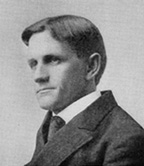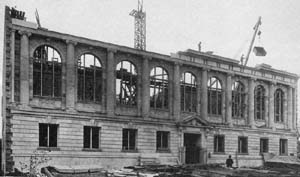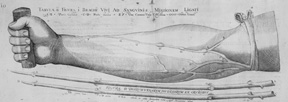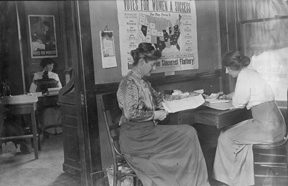
Leaf from Bible, Book of Acts
English 12th c.
(Special Collections, Ellis Library)
The first professionally trained librarian, James Thayer Gerould, arrived at the University of Missouri at the turn of the century. Gerould was the Assistant Librarian at Columbia University in New York, and he traveled to Missouri for an annual salary of $1500 per year and a month of vacation. When the Board of Curators decided to improve the University Library in 1900, they also hired staff to assist Gerould: a First Assistant Librarian, a Cataloguer, an Assistant Cataloguer and a Copyist. Gerould envisioned what we would recognize today at Ellis Library, freely circulating books and comfortable reading and work areas. In support of his vision of a main campus library, he began the long and slow campaign with the Curators and the Missouri General Assembly to fund a new library building.

Librarian James Thayer Gerould had many colleagues with whom to consult. In 1900, there were 664 members of the American Library Association.
(University Archives, History of the Library p.46)
Henry Ormal Severance guided the Library helm for three decades (1907-1937). Excluding the war years, the administration generously opened the University's pocketbook and shared much with the Library. Under A. Ross Hill, University President until 1921, the Library received significant appropriations and an increased staff, which made service more efficient than ever. Most importantly, Hill's dedication to the Library eventually translated into $200,000 for the central section of a new library building. In 1915, the cramped quarters of the west wing of Jesse Hall were exchanged for a new library structure.

With the construction of this Main Library, students and faculty no longer had to compete with the sounds of basketballs and hockey sticks; the former library was in Jesse Hall below the Women's Gymnasium and above the Men's.
(University Archives, The History of the University of Missouri Columbia Library, 1839-1989 p.5)
The new Library facility, of English Renaissance architecture, connected the West campus with the East Campus. This central location became the embodiment of University President Stratton Brooks' words, "A record of the heartbeats of a man would cover his entire life. In like manner, the history of a university library would cover the entire life of the university, because the library is the heart of the university." Brooks, President from 1923 to 1930, indeed took his statement to "heart," since during his administration, the Library received its largest appropriations to date.

This illustration from Valves of the Veins, written by Fabricius and published in 1603, highlights his discovery that valves direct blood flow to the heart.
(Special Collections, Ellis Library)
Great change permeated the social fabric of the nation in the 1920s, from the jazz revolution to politics, from fashion to the invention of radio. University Librarian Severance was very concerned with students purloining books and the "free and promiscuous use of the stacks." This Midwestern campus heard the drumbeat of change quite loudly when Psychology faculty members oversaw the distribution to students of a "Sex Questionnaire." Before the scandal and the embarrassment caused by it were over, both professors involved were dismissed and the Board of Curators replaced President Brooks. The Library got its own dose of the rebelliousness and restlessness of the 1920s when an "epidemic" of fictitious signatures to check out books appeared. There were four convictions in 1921 and eight in 1923.

A major social change occurred in 1920 with the Ratification of 19th Amendment, granting women the right to vote.
(University Archives, McFadden Family Collection, C:0/3/7, Album 1)
